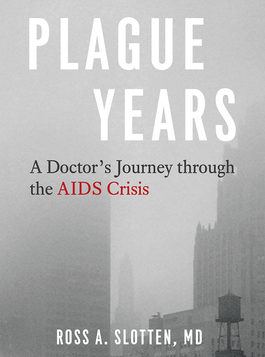 PLAGUE YEARS
PLAGUE YEARS
A Doctor’s Journey through the AIDS Crisis
by Ross A. Slotten, MD
University of Chicago Press. 214 pages, $20.
JUST FORTY YEARS AGO, in 1981, pockets of the U.S. began seeing mini-epidemics among gay men afflicted with diseases that made no sense, suffering maladies that were rare or unseen among men in their prime. The disease was called GRID (for Gay Related Immune Deficiency) at first, before the acronym was changed to AIDS.
At about that time, Ross A. Slotten had recently become a medical doctor and had cofounded a private practice in conjunction with National Health Service Corps, which had paid for his medical education. As long as he and his business partner served Chicago’s marginalized population, their obligation was being met. Due to the location of their practice—near the “Boystown” area of Chicago—and because that was a time when gay men and AIDS sufferers were often “kicked out of the previous doctors’ practices,” Slotten and his partner became de facto AIDS doctors with privileges at St. Joseph’s Hospital in Chicago.
This is a promising opening for a memoir, but because we know how the next few years will unfold, there’s also a certain sense of dread from the outset of the story—a sense of malevolence mixed with denial in what lies ahead. That feeling heightens when Slotten admits that he once had a relationship with a man who slept around.
But to start at the beginning: the author tells us, perhaps with a tinge of wryness, that throughout his childhood he thought he was straight; he dated girls and imagined a life with wife and children. He began to focus on himself in college, finally concluding that he was gay. What’s more, he wanted a boyfriend, and thought he’d finally found one with a man named Art. Readers who’ve been there will see red flags in Slotten’s story of his tumultuous, unprotected-sex relationship with Art, but Slotten was in love and thought Art was, too. He didn’t see problems until years had passed and Art finally broke his heart.
Many more years went by before Art showed up at the hospital. Slotten’s account of what happened next makes for a tense reading experience. Indeed the entire story of his love for a man who broke his heart sets us up for many pages of suspense. This story is woven in with memories of his young adulthood and middle years spent medically caring for AIDS patients, particularly gay men. As he comes to terms with his own advice to get tested—something he had avoided doing himself—readers may feel as if they’re holding onto a fraying rope, an emotion made even sharper by the fact that Slotten is in a long-term relationship at this point.
The author reminds us of the public’s paranoid response to AIDS patients back then, and of the guilty panic that most straight people, including medical personnel, felt during the worst of the epidemic. In the early years, what comes through loud and clear is the sense of hopelessness that doctors felt, the care given even knowing it was ineffectual, the frustration of treating patients whose minds were sharp but whose bodies were failing, or in some cases the reverse. He captures the fear that a positive diagnosis brought. He writes of attending several conferences overseas, and the bafflement of experts in various medical fields. He also writes about traveling to Africa, where AIDS was a disease largely of heterosexuals. He mentions several times how much we’ve learned and how much medical science has advanced in the last forty years.
Terri Schlichenmeyer is a freelance writer based in Wisconsin.






